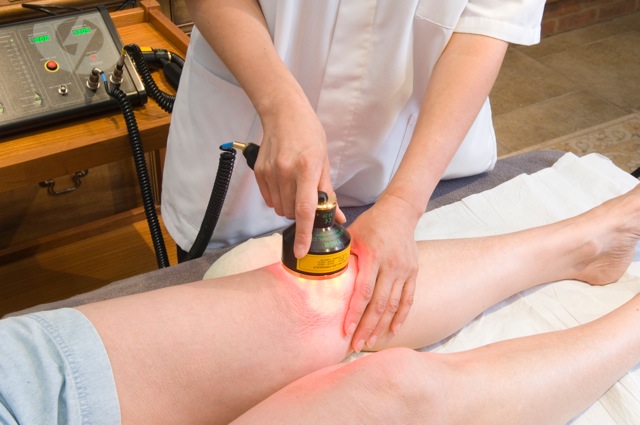Excitement About Photobiomodulation
Wiki Article
The Only Guide for Photobiomodulation
Table of ContentsPhotobiomodulation Fundamentals ExplainedSome Known Details About Photobiomodulation The Best Strategy To Use For PhotobiomodulationThe Of Photobiomodulation
Laser therapy is a medical therapy that makes use of concentrated light to boost a process called. During PBM, photons enter the cells and communicate with the cytochrome c complex within mitochondria. This interaction causes an organic waterfall of occasions that results in an increase in mobile metabolic rate, which can as well as accelerate the recovery procedure.There is agreement that the application of a restorative dose of light to impaired or dysfunctional cells leads to a mobile action moderated by mitochondrial systems. Photobiomodulation. Research studies have actually revealed that these modifications can affect pain and inflammation, along with, tissue fixing
Adjustments in ATP, responsive oxygen types and nitric oxide comply with light absorption by Cc, O. These impacts are redox state and dosage reliant. In hypoxic or otherwise stressed out cells it has been revealed lot of times that adhering to, nitric oxide is released, ATP is enhanced and oxidative stress and anxiety is reduced [27-31]

Getting The Photobiomodulation To Work
PBM gadgets have been removed for advertising and marketing by FDA with the Premarket Notification/510( k) process as adjunctive tools for the temporary relief of pain. These clearances were based on the presentation of scientific data to sustain such cases (Photobiomodulation). In this therapy, a light source is put near or touching the skin, permitting the light energy (photons) to penetrate tissue where it connects with chromophores located in cells leading to photophysical and photochemical adjustments that bring about modifications at the molecular, cellular and tissue degrees of the bodyRemarkably, current research shows that light can enhance performance in regular cells and cells. The possible applications of PBMT are numerous and are being explored experimentally at the fundamental science, pre-clinical and professional level. The current scientific usages are for the alleviation of discomfort and inflammation and the therapy of sporting activities injuries.

The therapy specifications and number of sessions required for PBMT depend Check This Out on location and reason. PBMT generally needs greater than one treatment for optimal pain relief. It may take numerous therapies for the results to become noticeable. reports that it can take anywhere from 8 to 30 sessions for a therapy to be totally reliable, and some people find it needed to go through treatment 2 to four times per week.
Some Ideas on Photobiomodulation You Need To Know
Therapy specifications for PBMT were initially developed utilizing cells in vitro and in tiny animal models. These therapy specifications usually had a low irradiance and fluence and worked well for cutaneous applications. When medical professionals began to use PBMT to deal with structures that were located much deeper in the body, they made More Bonuses use of these specifications with negative outcomes.
We now understand that these negative research studies was because of inaccurate device and therapy criteria for transcutaneous therapy of much deeper structures. Recent advances in laser treatment gadgets and more research right into the proper dosages have dramatically enhanced the outcomes of PBMT. For this hyperlink treating deep tissues, the wavelength of light made use of figures out the deepness of penetration into a cells.
It is vital that a medical professional utilizes the suitable wavelength of light and parameters to treat a problem. One wavelength and one collection of treatment parameters will certainly not be efficient for all conditions. Unfavorable side results have not been reported from the use of PBMT.
Photobiomodulation Fundamentals Explained
In the initial experiment, Dr. Endre Mester, used cut rats and observing how the laser affected their capability to grow hair compared to the group that was not obtaining LLLT. He found that the team of computer mice getting LLLT were able to grow their hair back a lot more promptly than the team of computer mice that really did not obtain LLLT (Hoon C, et al; 2012).This therapy is labelled in this manner to differentiate the distinction in between the lasers some careers make use of to cut (eg. in surgical treatments, or dental procedures). Low-level light treatment is painless, non-invasive treatment. It is used to decrease inflammation, swelling, and persistent joint conditions, minimize pain and accelerate wound recovery of nerves and cells (Hoon C, et al; 2012).
LLLT has a biphasic feedback, suggesting that lower dosages are generally seen to be much more helpful than greater dosages. That being stated, dosages higher or lower than the optimum dosage doesn't affect (Hoon C, et al; 2012). Consequently, it can be difficult to have researches on LLLT with so many criteria.
Some companies incorporated the 2 (LED and laser) to supply a more well-shaped therapy given that lasers can penetrate much deeper than LED and infrared light (Norman Doidge, The Brain's Means of Healing, 2015). During treatment, the area that is being dealt with is revealed to LED light from a Bio, Flex Laser, which is at 660 nm wavelength, adhered to by infrared light at 830-840 nm wavelength.
Report this wiki page